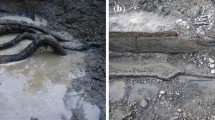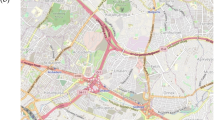Abstract
The concept of seismic resilience has received significant attention from academia and industry during the last two decades. Different frameworks have been proposed for seismic resilience assessment of engineering systems at different scales (e.g., buildings, bridges, communities, and cities). Testbeds including Centerville virtual community (CVC), Memphis testbed (MTB), and the virtual city of Turin, Italy (VC-TI) have been developed during the last decade. However, the resilience assessment results of Chinese cities still require calibration based on a unified evaluation model. Therefore, a geographic information system (GIS)-based benchmark model of a medium-sized city located in the southeastern coastal region of China was developed. The benchmark city can be used to compare existing assessment frameworks and calibrate the assessment results. The demographics, site conditions, and potential hazard exposure of the benchmark city, as well as land use and building inventory are described in this paper. Data of lifeline systems are provided, including power, transportation, water, drainage, and natural gas distribution networks, as well as the locations of hospitals, emergency shelters, and schools. Data from past earthquakes and the literature were obtained to develop seismic fragility models, consequence models, and recovery models, which can be used as basic data or calibration data in the resilience assessment process. To demonstrate the completeness of the data included in the benchmark city, a case study on the accessibility of emergency rescue after earthquakes was conducted, and the preliminary results were discussed. The ultimate goal of this benchmark city is to provide a platform for calibrating resilience assessment results and to facilitate the development of resilient cities in China.
Similar content being viewed by others
References
Almufti I and Willford M (2013), REDi™ Rating System: Resilience-Based Earthquake Design Initiative for the Next Generation of Buildings, San Francisco, CA: Arup.
Bruneau M, Chang SE, Eguchi RT, Lee GC, O’Rourke TD, Reinhorn AM, Shinozuka M, Tierney K, Wallace WA and Winterfeldt DV (2003), “A Framework to Quantitatively Assess and Enhance the SeismicResilience of Communities,” Earthquake Spectra, 19(4): 733–752.
Bruneau M and Reinhorn AM (2007), “Exploring the Concept of Seismic Resilience for Acute Care Facilities,” Earthquake Spectra, 23(1): 41–62.
Burton HV, Deierlein G, Lallemant D and Singh Y (2017), “Measuring the Impact of Enhanced Building Performance on the Seismic Resilience of a Residential Community,” Earthquake Spectra, 33(4): 1347–1367.
Chang SE and Shinozuka M (2004), “Measuring Improvements in the Disaster Resilience of Communities,” Earthquake Spectra, 20(3): 739–755.
Cimellaro G P, Fumo C, Reinhorn A M and Bruneau M (2009), “Quantification of Disaster Resilience of Health Care Facilities,” Technical Report, MCEER-09-0009, September 14.
Cimellaro GP, Reinhorn AM and Bruneau M (2010), “Seismic Resilience of a Hospital System,” Structure & Infrastructure Engineering, 6(1–2): 127–144.
Cimellaro GP, Reinhorn AM and Bruneau M (2011), “Performance-Based Metamodel for Healthcare Facilities,” Earthquake Engineering & Structural Dynamics, 40(11): 1197–1217.
Cimellaro GP, Renschler C, Reinhorn AM and Arendt L (2016), “PEOPLES: A Framework for Evaluating Resilience,” Journal of Structural Engineering, 142(10): 04016063.
Djalante R, Thomalla F, Sinapoy MS and Carnegie M (2012), “Building Resilience to Natural Hazards in Indonesia: Progress and Challenges in Implementing the Hyogo Framework for Action,” Natural Hazards, 62(3): 779–803.
Dong Y and Frangopol DM (2016), “Probabilistic Assessment of an Interdependent Healthcare-Bridge Network System Under Seismic Hazard,” Structure and Infrastructure Engineering, 13(1): 160–170.
Ellingwood BR, Cutler H, Gardoni P, Peacock WG, Van d LJW and Wang NY (2016), “The Centerville Virtual Community: a Fully Integrated Decision Model of Interacting Physical and Social Infrastructure Systems,” Sustainable & Resilient Infrastructure, 1(3–4): 95–107.
FEMA P58 (2012), Seismic Performance Assessment of Buildings, Volume 1 Methodology, Applied Technology Council (ATC), Redwood City, USA.
FEMA (2020), Summary of Stakeholder Feedback: Building Resilient Infrastructure and Communities (BRIC), Federal Emergency Management Agency, Washington, D.C, USA.
Filiatrault A and Sullivan T (2014), “Performance-Based Seismic Design of Nonstructural Building Components: The Next Frontier of Earthquake Engineering,” Earthquake Engineering and Engineering Vibration, 13(1): 17–46.
GBJ 11-89 (1989), Code for Seismic Design of Buildings, China Architecture and Building Press, Beijing, China. (in Chinese)
GB 50011-2001 (2001), Code for Seismic Design of Buildings, China Architecture and Building Press, Beijing, China. (in Chinese)
GB 50011-2010 (2010), Code for Seismic Design of Buildings, China Architecture and Building Press, Beijing, China. (in Chinese)
GB 18306-2015 (2015), Seismic Ground Motion Parameters Zonation Map of China, Standardization Administration of China, Beijing, China. (in Chinese)
GB/T 18208.4-2011 (2012), Post-Earthquake Field Works — Part 4: Assessment of Direct Loss, Standardization Administration of China, Beijing, China. (in Chinese)
GB/T 38591-2020 (2020), Standard for Seismic Resilience Assessment of Buildings, Standardization Administration of China, Beijing, China. (in Chinese)
HAZUS-MH MR3 (2003), “Multi-Hazard Loss Estimation Methodology-Earthquake Model,” Technical Manual, Department of Homeland Security, Washington, DC, USA.
Hingorania R, Tannera P, Prietob M and Laraa C (2020), “Consequence Classes and Associated Models for Predicting Loss of Life in Collapse of Building Structures,” Structural Safety, 85: 101910.
Hong HP and Chao F (2019), “On the Ground-Motion Models for Chinese Seismic Hazard Mapping,” Bulletin of the Seismological Society of America, 109(5): 2106–2124.
Hu Y, Dargush GF and Shao XY (2012), “A Conceptual Evolutionary Aseismic Decision Support Framework for Hospitals,” Earthquake Engineering and Engineering Vibration, 11(4): 499–512.
Kammouh O, Cimellaro GP and Mahin SA (2018), “Downtime Estimation and Analysis of Lifelines After an Earthquake,” Engineering Structures, 173: 393–403.
Kelman I and Glantz MH (2015), “Analyzing the Sendai Framework for Disaster Risk Reduction,” International Journal of Disaster Risk Science, 6(2): 105.
Kyriazis P (2013), “Systemic Seismic Vulnerability and Risk Analysis for Buildings, Lifeline Networks and Infrastructures Safety Gain,” SYNER-G FINAL REPORT, CP-IP 244061, Aristotle University of Thessaloniki, Greece.
Li JC, Wang T and Shang QX (2019), “Probability-Based Seismic Reliability Assessment Method for Substation Systems,” Earthquake Engineering and Structural Dynamics, 48: 328–346.
Li YM, Li YZ and Yang BY (2017), “Performance-Based Seismic Fragility Analysis of Steel Frame Structures,” Earthquake Resistant Engineering and Retrofitting, 39(4): 55–59. (in Chinese)
Lin QL, Lin JQ and Liu JL (2017), “A Study on the Fragility of Highway Bridges in the Wenchuan Earthquake,” Journal of Vibration and Shock, 36(4): 110–118. (in Chinese)
Lu Y, Mosqueda G, Han Q and Zhao Y (2018), “Shaking Table Tests Examining Seismic Response of Suspended Ceilings Attached to Large-Span Spatial Structures,” Journal of Structural Engineering, 144(9): 04018152.
Miles SB and Chang SE (2006), “Modeling Community Recovery from Earthquakes,” Earthquake Spectra, 22(2): 439–458.
Monsalve M and de la Llera J C (2019), “Data-Driven Estimation of Interdependencies and Restoration of Infrastructure Systems,” Reliability Engineering & System Safety, 181: 167–180.
National Institute of Standards and Technology (NIST) (2016), “Community Resilience Planning Guide for Buildings and Infrastructure Systems,” NIST Special Publication 1190, U.S. Department of Commerce.
Nie GZ, Gao JG, Su GW and Wang JM (2001), “Models on Rapid Judgement for the Emergent Rescue Needs During Earthquake,” 23(1): 69–76. (in Chinese)
Noori AZ, Marasco S, Kammouh O, Domaneschi M and Cimellaro GP (2017), “Smart Cities to Improve Resilience of Communities,” 8th International Conference on Structural Health Monitoring of Intelligent Infrastructure, Brisbane, Australia, December 5–8.
Pali T, Macillo V, Terracciano M T, Bucciero B, Fiorino L and Landolfo R (2018), “In-Plane Quasi-Static Cyclic Tests of Nonstructural Lightweight Steel Drywall Partitions for Seismic Performance Evaluation,” Earthquake Engineering & Structural Dynamics, 47(6): 1566–1588.
Planning Administration of Rugao (PAR) (2017), “General Urban Planning of Rugao (2013–2030),” Planning Administration of Rugao. (in Chinese)
Pitilakis K, Franchin P, Khazai B and Wenzel H (2014), SYNER-G: Systemic Seismic Vulnerability and Risk Assessment of Complex Urban, Utility, Lifeline Systems and Critical Facilities: Methodology and Applications, vol 31. Springer, Netherlands.
Reiner M and McElvaney L (2017), “Foundational Infrastructure Framework for City Resilience,” Sustainable and Resilient Infrastructure, 2(1): 1–7.
San Francisco Bay Area Planning and Urban Research Association (SPUR) (2008), “The Resilient City: Defining what San Francisco Needs from Its Seismic Mitigation Policies,” SPUR Report, SPUR Board of Directors.
Shang QX, Wang T and Li JC (2020), “Seismic Resilience Assessment of Emergency Departments Based on the State Tree Method,” Structural Safety, 85: 101944.
Steelman JS and Hajjar JF (2008). “Capstone Scenario Applications of Consequence-Based Risk Management for the Memphis Testbed,” Mid-American Earthquake Center, Department of Civil and Environmental Engineering, University of Illinois at Urbana-Champaign, Urbana, Illinois, USA, September.
Taghavi S and Miranda E (2003), “Response Assessment of Nonstructural Building Elements,” PEER Report 2003/05, Pacific Earthquake Engineering Research Center, Berkeley, CA, USA.
United Nations International Strategy for Disaster Reduction (UNISDR) (2007), Words into Action: a Guidance for Implementing the Hyogo Framework-Hyogo Framework for Action 2005–2015: Building the Resilience of Nations and Communities to Disasters, UNISDR, Geneva Switzerland.
United Nations International Strategy for Disaster Reduction (UNISDR) (2015), Sendai Framework for Disaster Risk Reduction 2015–2030, UNISDR, Geneva Switzerland.
Wang T, Shang QX, Chen X and Li JC (2019), “Experiments and Fragility Analyses of Piping Systems Connected by Grooved Fit Joints With Large Deformability,” Frontiers in Built Environment, 5: 49.
Xiong LH (2004), “Study on Seismic Performance of Small Hollow Concrete Block Buildings,” PhD Dissertation, Institute of Engineering Mechanics, China Earthquake Administration. (in Chinese)
Xiong C, Huang J and Lu XZ (2020), “Framework for City-Scale Building Seismic Resilience Simulation and Repair Scheduling with Labor Constraints Driven by Time-History Analysis,” Computer-Aided Civil and Infrastructure Engineering, 35(4): 322–341.
Xu MY (2019), “Seismic Fragility Analysis of Frame-Shear Structures Based on New Intensity Measures and CPU Parallel Computing,” Master Dissertation, Harbin Institute of Technology. (in Chinese)
Yodo N and Wang P (2016), “Engineering Resilience Quantification and System Design Implications: A Literature Survey,” Journal of Mechanical Design, 138(11): 111408.
Yu XH, Lu D and Li B (2016), “Estimating Uncertainty in Limit State Capacities for Reinforced Concrete Frame Structures Through Pushover Analysis,” Earthquakes and Structures, 10(1): 141–161.
Acknowledgement
This research was funded by the Scientific Research Fund of Institute of Engineering Mechanics, China Earthquake Administration (Grant Nos. 2019EEEVL0505, 2019B02 and 2019A02) and Heilongjiang Touyan Innovation Team Program. Any opinions, findings and conclusions or recommendations expressed in this paper are those of the authors and do not necessarily reflect the views of the sponsors.
Author information
Authors and Affiliations
Corresponding author
Additional information
Supported by
Scientific Research Fund of Institute of Engineering Mechanics, China Earthquake Administration under Grant Nos. 2019EEEVL0505, 2019B02 and 2019A02 and Heilongjiang Touyan Innovation Team Program
Rights and permissions
About this article
Cite this article
Shang, Q., Guo, X., Li, Q. et al. A benchmark city for seismic resilience assessment. Earthq. Eng. Eng. Vib. 19, 811–826 (2020). https://doi.org/10.1007/s11803-020-0597-3
Received:
Accepted:
Published:
Issue Date:
DOI: https://doi.org/10.1007/s11803-020-0597-3




